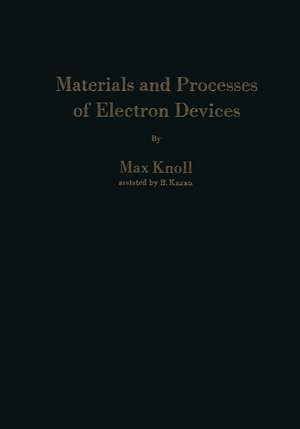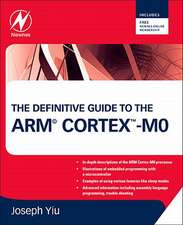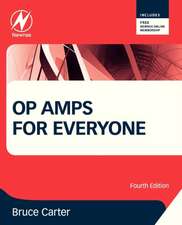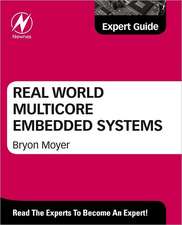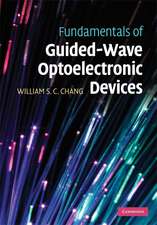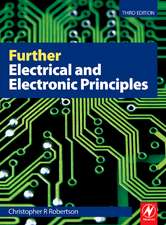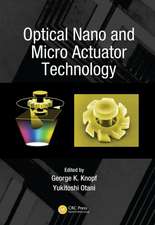Materials and Processes of Electron Devices: Werkstoffe und Verfahren zur Herstellung von Entladungsgeräten / Matériaux et procédés pour la construction d’appareils de décharges électriques / Materiales y procesos de fabricación para elementos electrónicos
Benjamin Kazan Autor Max Knollen Limba Engleză Paperback – 21 mar 2012
Preț: 654.43 lei
Preț vechi: 769.92 lei
-15% Nou
Puncte Express: 982
Preț estimativ în valută:
125.22€ • 131.10$ • 103.62£
125.22€ • 131.10$ • 103.62£
Carte tipărită la comandă
Livrare economică 05-19 aprilie
Preluare comenzi: 021 569.72.76
Specificații
ISBN-13: 9783642459382
ISBN-10: 3642459382
Pagini: 512
Ilustrații: XVI, 484 p.
Dimensiuni: 170 x 244 x 27 mm
Greutate: 0.81 kg
Ediția:Softcover reprint of the original 1st ed. 1959
Editura: Springer Berlin, Heidelberg
Colecția Springer
Locul publicării:Berlin, Heidelberg, Germany
ISBN-10: 3642459382
Pagini: 512
Ilustrații: XVI, 484 p.
Dimensiuni: 170 x 244 x 27 mm
Greutate: 0.81 kg
Ediția:Softcover reprint of the original 1st ed. 1959
Editura: Springer Berlin, Heidelberg
Colecția Springer
Locul publicării:Berlin, Heidelberg, Germany
Public țintă
ResearchCuprins
1 General Structure and Properties of Materials (Including Metallographic Methods).- 1.1 Crystallization.- 1.2 Shaping of Crystals by Cold Working (cleavage and slip planes, work hardening ductility, malleability, brittleness).- 1.3 Recrystallization (growth of new crystals during annealing).- 1.4 Creep Limit and Form Retention.- 1.5 Impurities.- 1.6 Cast Metal Alloys.- Components Miscible in Liquid and Solid States..- Components Miscible in Liquid State Only (“mixed crystals”). (Eutectic alloys, type II)..- Components Miscible in Liquid State and Partially or Completely Miscible in Solid State. (Type II alloys.).- Components Partially Miscible in Liquid State, not Miscible in Solid State. (Type IV alloys.).- Compound-Forming Alloys. (Type V alloys.).- 1.7 Sintered Metals and Alloys (powder metallurgy).- 1.8 Structure of Glasses; Phase and Viscosity Diagrams.- 1.9 References on General Structure and Properties of Materials.- General..- Crystallization..- Shaping of Crystals by Cold Working..- Recrystallization..- Creep Limit and Form Retention..- Impurities..- Cast Metal Alloys..- Sintered Metals and Alloys..- Structure of Glasses; Phase and Viscosity Diagrams..- 2 Testing Methods for Vacuum Tube Materials.- 2.1 Spectral Analysis.- X-Ray Spectrography..- Light Spectrography..- 2.2 X-Ray Radiography.- 2.3 Inspection of Strains in Glass with the Polariscope.- Polaroid Polarizer or Analyzer..- Sensitive Tint Plate for Detecting Very Slight Strains..- Circular Polariscope..- Babinet Compensator..- Possible Errors..- Typical Causes for Strain..- 2.4 Thickness Measurement of Thin Films.- Interference Method..- X-Ray Absorption Method,.- 2.5 Measurement of Expansion (dilatometer).- 2.6 Pyrometers.- 2.7 Black-Body Radiation.- 2.8 Testing Instruments for LuminescentMaterials.- 2.9 Leak Detectors.- Rate of Rise Method..- Spark Coil Search Method..- Gas Discharge Color Method..- Thermal Conductivity Method..- Ionization Method..- Radium Ionization Gauge..- Hot Filament Ionization Gauge..- Cold Cathode Penning Ionization Gauge..- Hydrogen Pd Valve Method..- Contamination Method..- Mass Spectrometer Method..- Differential Condensation (or Absorption) Method..- Halogen Leak Detectors..- Knudsen Gauge..- 2.10 References on Testing Methods for Vacuum Tube Materials.- General..- Special Analysis..- X-Ray Radiography..- Inspection of Strains in Glass with the Polariscope..- Thickness Measurements of Thin Films..- Measurement of Expansion..- Pyrometers..- Testing Instruments for Luminous Materials..- Leak Detectors..- 3 High Melting Metals and Alloys in Tube Design.- 3.1 Tungsten.- General Physical Constants of Tungsten..- Methods of Oredressing..- Extraction of Tungsten from Tungstic Acid..- Manufacture of Raw Tungsten..- Influence of Admixtures on the Metallographic Properties..- Hot Tensile Strength and Ultimate Elongation..- Modulus of Elasticity and Modulus of Torsion..- Thermal Data..- Chemical Properties..- Typical Vacuum Tube Elements Made from Tungsten..- 3.2 Molybdenum.- Physical Constants..- Methods of Oredressing..- Metal Extraction..- Manufacture of Raw Molybdenum..- Physical Properties and Workability..- Chemical Properties..- Technical Applications..- 3.3 Tungsten-Molybdenum Alloys.- 3.4 Tantalum.- Physical Constants..- Oredressing and Metal Extraction..- Physical Properties..- Chemical Properties..- Gas Evolution Characteristic..- Gas Absorption Characteristic..- Heat Radiation Characteristic and Output..- 3.5 Columbium (Niobium).- 3.6 Metals of the Platinum Group and their Alloys.- Physical Constants of Pure Platinum..- Oredressing and Manufacture..- Physical Properties..- Chemical Properties..- Technical Applications..- 3.7 Palladium.- 3.8 Zirconium.- Physical Constants..- Extraction and Physical Properties..- Chemical Properties..- Technical Applications..- 3.9 Titanium.- 3.10 Rhenium.- Physical Constants of Rhenium..- Extraction and Working..- 3.11 References on High Melting Metals.- Condensed Papers and Books on Tungsten..- Physical and Chemical Properties of Tungsten..- Manufacturing of Tungsten..- Filaments for Incandescent Lamps and Cathodes..- Other Applications..- Molybdenum..- Tungsten-Molybdenum Alloys..- Tantalum and Columbium..- Platinum and its Alloys..- Palladium..- Zirconium..- Titanium..- Thorium..- Rhenium..- 4 Base Metals in Tube Design.- 4.1 General Remarks.- 4.2 Nickel.- Physical Constants of Pure Nickel..- Oredressing and Extraction..- Raw Working of Nickel..- Physical Properties and Working..- Chemical Properties..- Technical Applications..- 4.3 Iron.- Physical Constants of Pure Iron..- Oredressing and Extraction..- Raw Working..- Physical Properties and Working..- Chemical Properties..- Technical Applications..- 4.4 Copper.- Physical Constants of Pure Copper..- Oredressing and Extraction..- Working and Physical Properties..- Chemical Properties..- Technical Applications..- 4.5 Aluminum.- Physical Constants of Aluminum..- Oredressing and Extraction..- Working and Physical Properties..- Chemical Properties..- 4.5 a Indium.- 4.6 Silver.- Physical Constants of Silver..- Extraction and Properties..- Applications..- 4.7 Beryllium.- Physical Constants of Beryllium..- Extraction and Properties..- Chemical Properties..- Technical Applications..- 4.8 Mercury.- Extraction..- Purification..- Physical Properties..- Chemical Properties..- Precautions During Working..- TechnicalApplications..- 4.9 Alkaline Metals and Alkaline-Earth Metals.- General Remarks..- Potassium and Sodium..- Barium and Strontium..- Calcium..- Cesium..- Rubidium..- Lithium..- Magnesium..- 4.10 Antimony.- 4.11 References on Base Metals.- General..- Nickel..- Iron..- Copper..- Aluminum..- Indium..- Silver..- Beryllium..- Mercury..- Alkali Metals and Alkali Earths Including Alloys..- Antimony..- 5 Alloys of Base Metals.- 5.1 Introduction.- 5.2 Fe-Ni alloys.- Fe-Ni Alloys for Glass Sealings..- Invar..- Frigidal..- Kovar..- Vacuum Melted Ni-Fe (and Cr-Fe) Alloys..- 5.3 Fe-Cr Alloys.- Chrome Iron for Glass Sealings..- Stainless Steel..- 5.4 Nickel Alloys.- Nickel-Chrome..- Nickel-Manganese..- Nickel-Beryllium..- Nickel-Cobalt..- Nickel-Barium..- Konel Metal..- Monel Metal..- 5.5 Copper Alloys.- Copper-Beryllium..- Copper-Nickel..- Copper-Zinc..- Copper-Tin..- 5.6 Alloys of Base Metals with High Melting Metals.- Iron-Molybdenum-Cobalt..- Nickel-Iron-Chromium-Molybdenum..- Nickel-Iron-Molybdenum..- Iron-Nickel..- Nickel-Iron-Tungsten..- Tungsten-Nickel-Cobalt..- Tungsten-Copper..- 5.7 References on Alloys of Ease Metals.- General..- Iron-Nickel Alloys..- Iron-Chromium Alloys..- Nickel Alloys..- Copper Alloys..- Alloys of Base Metals with High Melting Metals..- 6 Glasses. Quartz. Ceramics, etc..- 6.1 Manufacture, Composition, and General Properties of Glass.- 6.2 Special Physical and Chemical Properties of Glass.- Mechanical Properties..- Coefficient of Thermal Expansion..- Thermal Conductivity..- Electrical Conductivity and Electrolysis..- Dielectric Losses..- Dielectric Constant..- Electrical Breakdown..- Radiation Transmission..- Gas Tightness..- Chemical Resistivity..- Choice of Glasses According to Application..- 6.3 Quartz Glass and Quartzware.- Extraction..- Physical andChemical Properties..- Technical Applications..- 6.4 Ceramic Materials.- Hard Porcelain..- Magnesium Silicate..- Pure Metallic Oxides..- 6.5 Mica.- 6.6 Asbestos.- 6.7 Silicon Carbide.- 6.8 References on Manufacture, Composition, and General Properties of Glass (including handbooks).- 6.9 References on Physical and Chemical Properties of Glass.- 6.10 References on Quartz Glass and Quartzware.- 6.11 References on Ceramic Materials.- 6.12 References on Mica.- 6.13 References on Asbestos.- 6.14 References on Silicon Carbide.- 7 Semiconductors and Organic Materials.- 7.1 Selenium.- Production of Barrier Junctions and Rectifying Contacts..- 7.2 Germanium.- Preparation and Doping..- Production of Ohmic (Nonrectifying) Contacts..- Encapsulation..- 7.3. Silicon.- Production of Ohmic Contacts..- 7.4 Intermetallic Compounds.- 7.5 Carbon and Electrographite.- Manufacture..- Chemical Properties..- Technical Applications..- 7.6 Rubber.- 7.7 Stopcock Grease, Oil, and Cements.- Packing Grease..- Vacuum Oils..- Sealing Cements..- 7.8 Plastics for Electron Devices.- 7.9 Tube Basing Cements.- 7.10 References on Semiconductors in General.- 7.11 References on Selenium and Other Semiconductors.- 7.12 References on Germanium.- 7.13 References on Silicon.- 7.14 References on Electrographite.- 7.15 References on Rubber.- 7.16 References on Vacuum Greases, Oils, and Cements.- 7.17 References on Base Cements for Vacuum Tubes.- 8 Gases and Vapors and Their Use in Vacuum Tubes.- 8.1 General Properties and Selection.- Filling Pressure and Working Pressure..- Current Conduction..- Breakdown Voltage..- Back Ignition..- Cathode Drop and Cathode Sputtering..- Voltage Gradient of the Positive Column..- Light Production..- Other Applications..- 8.2 Noble Gases.- Extraction..- Purification..- Born Cell..-Gehlhoff-Schröter Cell..- Purity Test..- Filling Methods..- 8.3 Non-Noble Gases.- Hydrogen..- Oxygen..- Nitrogen..- Carbon Dioxide..- Physical and Chemical Properties..- Filling Methods..- 8.4 Vapors.- Extraction..- Physical and Chemical Properties..- Filling Methods..- Regulation of Vapor Pressure..- 8.5 References on Gases and Vapors.- General Properties and Comparative Properties..- Noble Gases..- Non-Noble Gases..- Vapors..- 9 Working and Pre-Outgassing of Metallic Vacuum Tube Parts.- 9.1 Shaping and Assembling.- 9.2 Outgassing of Metals.- Causes of Gas Content..- Quantity and Type of Gas..- Removal of Gases..- Outgassing of Metals by Melting..- General Remarks on Outgassing of Individual Parts (“firing”)..- Firing in High Vacuum..- Firing in Hydrogen..- 9.3 Reference on Working and Pre-Outgassing of Metallic Vacuum Tube Parts.- Shaping and Assembling..- Outgassing..- 10 Joining of Metal Parts.- 10.1 Spot Welding and Seam Welding.- 10.2 Butt Welding.- 10.3 Arc Welding.- Direct Current Arc Between Work and a Carbon Electrode..- Direct Current Arc Between Work and a Metal (puddling) Electrode..- Alternating-Current Between Carbon Rods..- 10.4 Coal-Gas Welding.- 10.5 Welding in Alternating Current with Atomic H2.- 10.6 Solder Joints.- Soft Solder..- Hard Solder..- 10.7 Cast Joints.- 10.8 Mechanical Connections.- “Rolling In”..- “Swaging In”..- “Pinched Joints”..- “Lapped Joints”..- Solid and Tubular Rivets..- Integral Hollow Rivets..- Screw Joints..- Mechanical Joints by Means of Wedges and Locks..- Binding..- Weaving..- 10.9 References on Joining of Metal Parts.- 11 Surface Treatment of Metallic Vacuum Tube Elements.- 11.1 Stamping.- 11.2 Sand Blasting.- 11.3 Polishing.- 11.4 Etching.- 11.5 Washing.- 11.6 Carbonization.- 11.7 ElectrolyticPrecipitation of Black Chromium.- 11.8 Electrolytic Precipitation of Black Ni.- 11.9 Oxidizing.- 11.10 Spraying or Painting with Metallic or Oxide Powders.- 11.11 Carburizing.- 11.12 Thermal Dissociation.- 11.13 Sublimation of Metallic Coatings in H2.- 11.14 Aluminizing.- 11.15 Enameling Metallic Surfaces.- 11.16 References on Surface Treatment of Metals.- 12 Shaping, Surface Treatment, and Degassing of Vacuum Tube Parts Made from Glass.- 12.1 Shaping of Glass.- Shaping of Raw Glass..- Additional Glass Working..- Tolerances..- Strains in Glass..- 12.2 Preparation of Glass Surfaces.- Chemical Cleaning..- Metallizing Processes..- Graphite Coating..- Etching..- Colored Coatings..- 12.3 Outgassing of Glass.- 12.4 References on Shaping, Surface Treatment, and Degassing of Vacuum Tube Parts Made from Glass.- 13 Exhaust Processes of Vacuum Tubes.- 13.1 General Remarks.- 13.2 Heating in the Oven (baking).- 13.3 Heating by Current Passage.- 13.4 High-Frequency Heating.- 13.5 Heating by Electron Bombardement.- 13.6 References on Exhaust Processes of Vacuum Tubes.- 14 Getters and Getter Processes.- 14.1 General.- Bulk Getters..- Coating Getters..- 14.2 Condensation on Cooled Surfaces.- 14.3 Adsorption by Carbon.- 14.4 Sorption by Solid Metals without Flashing.- Tantalum..- Tungsten and Molybdenum..- Columbium..- Zirconium..- Thorium..- Titanium..- Aluminum..- Copper, Potassium, Sodium, Tin..- Iron and Steel..- Uranium..- 14.5 Gettering by Evaporated Metals (flash gettering).- General..- Magnesium..- Barium..- Other Metal Vapors..- Undesired Effects of Metal Vapors..- 14.6 Technical Applications of Metal Getters.- 14.7 Gettering with Phosphorus.- 14.8 Comparison of Typical Getters.- 14.9 Drying Agents.- 14.10 References.- Fundamentals..- Gettering by Evaporated Metals and Alloys..- Gettering by Solid Metals and Alloys..- Gettering by Phosphorous, Charcoal, and Liquid Air..- Drying Agents..- Cleanup Effect..- Table A. 1 Periodic Chart of the Elements.- Table A. 2 Thermal and Other Properties of Atoms in Bulk (atomic number, atomic weight, density, crystal form, melting point, boiling point, thermal conductivity, coefficient of linear thermal expansion, electrical resistance).- Table A. 4 Data on Radioactive Isotopes.- Table A. 5 Absolute Units of Electricity.- Table A. 6 Temperature Conversion Table.- Fig. A/1 Vapor Pressure of Some Elements.- Fig. A/2 Nomograph for Determination of Meter Resistivity of Metal Wires.- Fig. A/3 Data for Incandescent Tungsten Wire in High Vacuum.- Fig. A/4 Determination of the True Temperature of Radiating Bodies.- Fig. A/5 Electron Range R in a Solid of Density ?.- References List of Tables and Diagrams in Appendix.- References on Condensed Papers and Books on Materials and Processes of Electron Devices.- Adresses of Companies.
